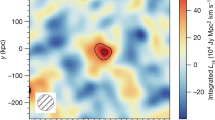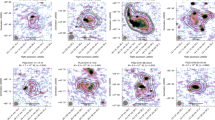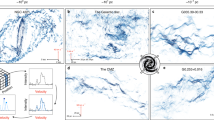Abstract
Dark and baryonic matter moved at different velocities in the early Universe, which strongly suppressed star formation in some regions1. This was estimated2 to imprint a large-scale fluctuation signal of about two millikelvin in the 21-centimetre spectral line of atomic hydrogen associated with stars at a redshift of 20, although this estimate ignored the critical contribution of gas heating due to X-rays3,4 and major enhancements of the suppression. A large velocity difference reduces the abundance of haloes1,5,6 and requires the first stars to form in haloes of about a million solar masses7,8, substantially greater than previously expected9,10. Here we report a simulation of the distribution of the first stars at redshift 20 (cosmic age of around 180 million years), incorporating all these ingredients within a 400-megaparsec box. We find that the 21-centimetre hydrogen signature of these stars is an enhanced (ten millikelvin) fluctuation signal on the hundred-megaparsec scale, characterized2 by a flat power spectrum with prominent baryon acoustic oscillations. The required sensitivity to see this signal is achievable with an integration time of a thousand hours with an instrument like the Murchison Wide-field Array11 or the Low Frequency Array12 but designed to operate in the range of 50–100 megahertz.
This is a preview of subscription content, access via your institution
Access options
Subscribe to this journal
Receive 51 print issues and online access
$199.00 per year
only $3.90 per issue
Buy this article
- Purchase on Springer Link
- Instant access to full article PDF
Prices may be subject to local taxes which are calculated during checkout




Similar content being viewed by others
References
Tseliakhovich, D. & Hirata, C. Relative velocity of dark matter and baryonic fluids and the formation of the first structures. Phys. Rev. D 82, 083520 (2010)
Dalal, N., Pen, U.-L. & Seljak, U. Large-scale BAO signatures of the smallest galaxies. J. Cosmol. Astroparticle Phys. 11, 007 (2010)
Madau, P., Meiksin, A. & Rees, M. J. 21 centimeter tomography of the intergalactic medium at high redshift. Astrophys. J. 475, 429–444 (1997)
Pritchard, J. R. & Furlanetto, S. 21-cm fluctuations from inhomogeneous X-ray heating before reionization. Mon. Not. R. Astron. Soc. 376, 1680–1694 (2007)
Maio, U., Koopmans, L. V. E. & Ciardi, B. The impact of primordial supersonic flows on early structure formation, reionization and the lowest-mass dwarf galaxies. Mon. Not. R. Astron. Soc. 412, L40–L44 (2011)
Naoz, S., Yoshida, N. & Gnedin, N. Y. Simulations of early baryonic structure formation with stream velocity: I. Halo abundance. Astrophys. J. 747, 128 (2012)
Stacy, A., Bromm, C. & Loeb, A. Effect of streaming motion of baryons relative to dark matter on the formation of the first stars. Astrophys. J. 730, L1 (2011)
Greif, T., White, S., Klessen, R. & Springel, V. The delay of population III star formation by supersonic streaming velocities. Astrophys. J. 736, 147 (2011)
Abel, T., Bryan, G. L. & Norman, M. L. The formation of the first star in the Universe. Science 295, 93–98 (2002)
Bromm, V., Coppie, P. S. & Larson, R. B. Forming the first stars in the Universe: The fragmentation of primordial gas. Astrophys. J. 527, L5–L8 (1999)
Bowman, J. D., Morales, M. F. & Hewitt, J. N. Foreground contamination in interferometric measurements of the redshifted 21 cm power spectrum. Astrophys. J. 695, 183–199 (2009)
Harker, G. et al. Power spectrum extraction for redshifted 21-cm Epoch of Reionization experiments: the LOFAR case. Mon. Not. R. Astron. Soc. 405, 2492–2504 (2010)
Tseliakhovich, D., Barkana, R. & Hirata, C. Suppression and spatial variation of early galaxies and minihalos. Mon. Not. R. Astron. Soc. 418, 906–915 (2011)
Fialkov, A., Barkana, R., Tseliakhovich, D. & Hirata, C. Impact of the Relative Motion between Dark Matter and Baryons on the First Stars. Mon. Not. R. Astron. Soc. (submitted); preprint at http://arxiv.org/abs/1110.2111.
Naoz, S., Noter, S. & Barkana, R. The first stars in the Universe. Mon. Not. R. Astron. Soc. 373, L98–L102 (2006)
Holzbauer, L. N. & Furlanetto, S. R. Fluctuations in the high-redshift Lyman-Werner and Lyman-alpha radiation backgrounds. Mon. Not. R. Astron. Soc. 419, 718–731 (2012)
Mesinger, A., Furlanetto, S. & Cen, R. 21CMFAST: a fast, seminumerical simulation of the high-redshift 21-cm signal. Mon. Not. R. Astron. Soc. 411, 955–972 (2011)
Barkana, R. & Loeb, A. Unusually large fluctuations in the statistics of galaxy formation at high redshift. Astrophys. J. 609, 474–481 (2004)
Aihara, H. et al. The eighth data release of the Sloan Digital Sky Survey: first data from SDSS-III. Astrophys. J. Suppl. 193, 29 (2011); erratum. 195, 26 (2011)
Colless, M. et al. The 2dF Galaxy Redshift Survey: spectra and redshifts. Mon. Not. R. Astron. Soc. 328, 1039–1063 (2001)
Springel, V., Frenk, C. S. & White, S. D. M. The large-scale structure of the Universe. Nature 440, 1137–1144 (2006)
Haiman, Z., Rees, M. J. & Loeb, A. Destruction of molecular hydrogen during cosmological reionization. Astrophys. J. 476, 458–463 (1997); erratum. 484, 985 (1997)
Barkana, R. & Loeb, A. Detecting the earliest galaxies through two new sources of 21 centimeter fluctuations. Astrophys. J. 626, 1–11 (2005)
Naoz, S. & Barkana, R. Detecting early galaxies through their 21-cm signature. Mon. Not. R. Astron. Soc. 385, L63–L67 (2008)
Furlanetto, S. R., Oh, S. P. & Briggs, F. H. Cosmology at low frequencies: the 21 cm transition and the high-redshift Universe. Phys. Rep. 433, 181–301 (2006)
Bouwens, R. J. et al. A candidate redshift z ≈ 10 galaxy and rapid changes in that population at an age of 500 Myr. Nature 469, 504–507 (2011)
Anderson, L. et al. The clustering of galaxies in the SDSS-III Baryon Oscillation Spectroscopic Survey: baryon acoustic oscillations in the Data Release 9 Spectroscopic Galaxy Sample. Preprint at http://arxiv.org/abs/1203.6594 (2012)
Barkana, R., Haiman, Z. & Ostriker, J. P. Constraints on warm dark matter from cosmological reionization. Astrophys. J. 558, 482–496 (2001)
McQuinn, M., Zahn, O., Zaldarriaga, M., Hernquist, L. & Furlanetto, S. R. Cosmological parameter estimation using 21 cm radiation from the epoch of reionization. Astrophys. J. 653, 815–834 (2006)
Liu, A. & Tegmark, M. How well can we measure and understand foregrounds with 21-cm experiments? Mon. Not. R. Astron. Soc. 419, 3491 (2012)
Acknowledgements
This work was supported by the Israel Science Foundation (for R.B., and E.V.’s stay at Tel Aviv University) and by the European Research Council (for A.F.). D.T. and C.M.H. were supported by the US Department of Energy and the National Science Foundation. C.M.H. is also supported by the David & Lucile Packard Foundation.
Author information
Authors and Affiliations
Contributions
R.B. initiated the project, and E.V. made the computations and figures by developing a code, parts of which were based on codes supplied by A.F., D.T. and C.M.H. The text was written by R.B. and edited by the other authors. A.F. added the L–W module for Supplementary section 3 and made Supplementary Fig. 1.
Corresponding authors
Ethics declarations
Competing interests
The authors declare no competing financial interests.
Supplementary information
Supplementary Information
This file contains Supplementary Text and Data 1-4, which comprises 1) a description of the simulation code; 2) a comparison with previous work on the dark matter to baryon velocity difference; 3) the expected timing of the three high-redshift feedback transitions and 4) observational considerations. Supplementary Figure 1 (on the Lyman-Werner feedback) and additional references are also included. (PDF 252 kb)
Rights and permissions
About this article
Cite this article
Visbal, E., Barkana, R., Fialkov, A. et al. The signature of the first stars in atomic hydrogen at redshift 20. Nature 487, 70–73 (2012). https://doi.org/10.1038/nature11177
Received:
Accepted:
Published:
Issue Date:
DOI: https://doi.org/10.1038/nature11177
This article is cited by
-
Astrophysical constraints from the SARAS 3 non-detection of the cosmic dawn sky-averaged 21-cm signal
Nature Astronomy (2022)
-
The REACH radiometer for detecting the 21-cm hydrogen signal from redshift z ≈ 7.5–28
Nature Astronomy (2022)
-
Formation of the First Stars and Black Holes
Space Science Reviews (2020)
-
Possible interaction between baryons and dark-matter particles revealed by the first stars
Nature (2018)
-
The numerical frontier of the high-redshift Universe
Computational Astrophysics and Cosmology (2015)
Comments
By submitting a comment you agree to abide by our Terms and Community Guidelines. If you find something abusive or that does not comply with our terms or guidelines please flag it as inappropriate.



